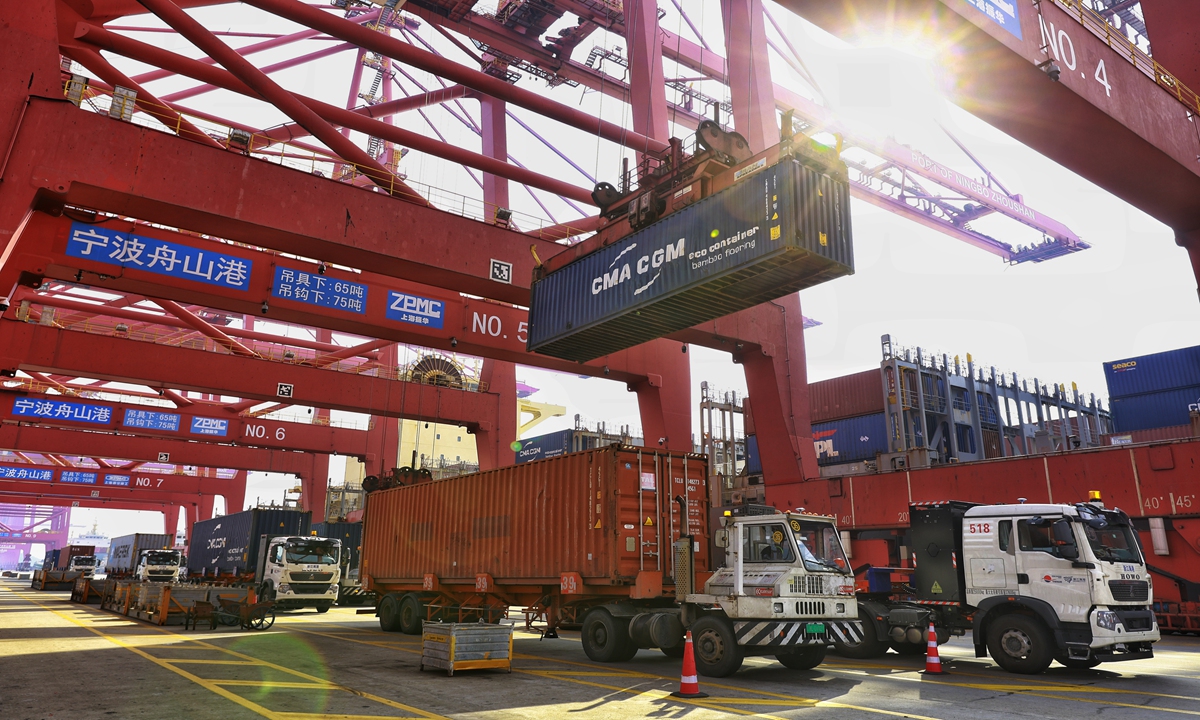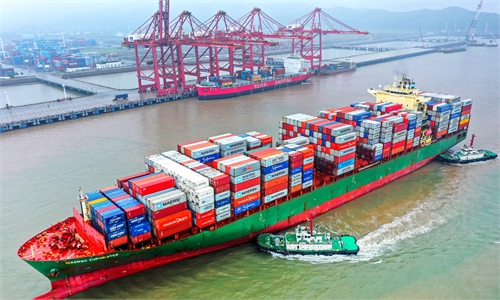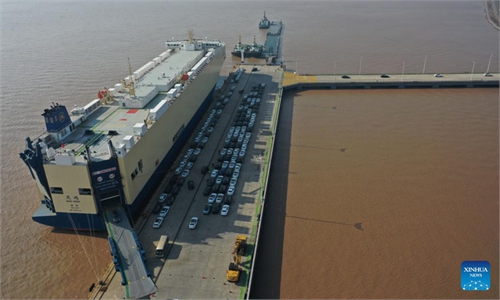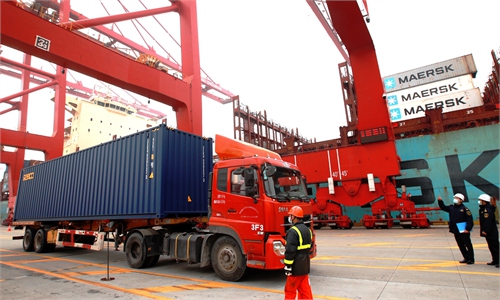GT on the spot: Top ports put more weight on domestic consumption in 2023: insiders

The busy scene at Dapukou terminal of Zhoushan Port, East China's Zhejiang Province on January 17, 2023 Photo: Li Hao/GT
Major Chinese ports, ranging from Ningbo Zhoushan Port in East China's Zhejiang Province to Qingdao Port in Shandong Province, are putting more focus on domestic consumption amid a rebound following China's optimized epidemic control.
They are seeking to compensate for weak demand overseas, which is posing a challenge to China's foreign trade growth in 2023.
High inflation rates, US monetary policy, the Russia-Ukraine conflict and other factors are pressuring the world economic recovery in the new year. That's pushing Chinese leading ports and traders, which are at the forefront of changing international trade, to respond.
Ningbo Zhoushan Port plans to keep up with the times by facilitating the economic pattern of "dual circulation" - China's new strategy that aims to serve economic development in China but also meet global demand, Ningbo Zhoushan Port Co said in a statement to the Global Times.
The plan includes adding routes that connect the east to the sea and the west to the inland of China, investing more in facilities and upgrading them, and strengthening ties with global shippers to better integrate domestic and foreign trade flows.
"When we made this year's budget, we focused on the strategic deployment of building a domestic trade base in Ningbo Zhoushan Port," Qian Yong, a deputy director of the business department of Ningbo Zhoushan Port Co, told the Global Times on Wednesday. The domestic trade business has always been the relatively weak segment of the port. For example, Ningbo Zhoushan Port has exported nearly 10 million heavy containers, but the total volume for domestic trade was just over 4 million, according to Qian.
Throughput of tens of thousands of containers may be needed in 2023 to compensate for the weak global trade situation, he said.
Rail-sea intermodal cargo trains are another focus for the company, where it has advantages. "We have three railway lines connecting to the port, which gives us certain edges [in terms of diversified transportation]," Qian said.
The change is an active approach to weak global demand, which is reflected in the poor forecasts of some shipping companies. An industry insider told the Global Times on condition of anonymity that some large shipping lines expect foreign trade in 2023 to shrink 5-10 percent.
"With more new ships being built, the business performance of some shipping companies this year may not look so good," the person said.
Haitian Holdings, a large Ningbo-based company specializing in foreign trade, has concerns about the sluggish world economic situation in 2023.
From December 1 to January 13, 2022, the company's trade with European countries dropped by 10 percent year-on-year, while that with the US took an even bigger hit of 25 percent. Some 90 percent of the traded goods are for export, ranging from food to daily commodities.
"There is much uncertainty about foreign trade in 2023, and we believe that the trade volume for the first quarter will drop," Liu Feilong, a deputy general manager of the company, told the Global Times on Wednesday.
"Our US customers focus more on prices instead of the functionality of a product these days," Liu said.
High US inflation and the Russia-Ukraine conflict have curbed demand in Western markets, the insider said.
Domestic consumption, which is highly expected to recover as China reopens, may be a new trend. But companies like Liu's are finding it difficult to switch from being foreign trade specialists to domestic trade-oriented firms, given the different standards and criteria of the products involved for the two different markets.
More government measures are landing on the ground to support these companies and help them adapt to the "dual circulation" mode in the new era.
China's Ministry of Commerce, together with 13 other ministries and departments, recently issued a list of pilot cities and provinces for boosting the integration of domestic and foreign trade-oriented firms. Nine cities and provinces, which are the cores of trade and manufacturing hubs, including Beijing, Shanghai, Jiangsu and Zhejiang, were on the list.
Corresponding industry clusters are to be established in these places with government support.
For example, the fourth phase of the fully automated terminal of Guangzhou Port was put into operation at the end of 2022, helping the Guangdong-Hong Kong-Macao Greater Bay Area to build a new "dual circulation" development pattern.
Qingdao Port, for its part, is focusing on two-way efforts by sea and land by building land ports, opening railway lines, and expanding the supply of goods to better serve domestic and foreign trade needs.



